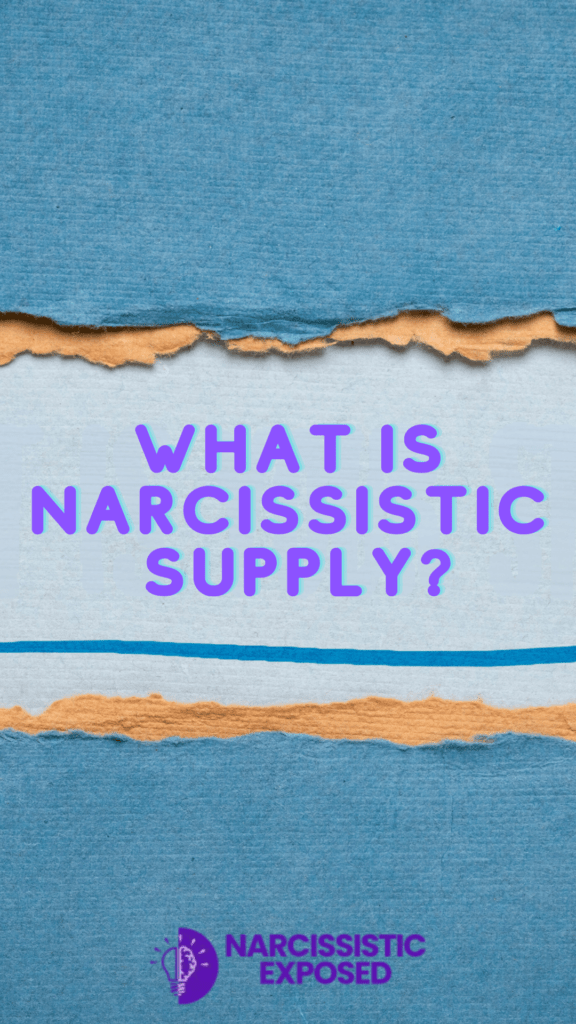
Narcissistic supply refers to the constant affirmation, admiration, and attention that narcissists seek to fulfill their deep-seated need for validation and self-esteem. It acts as a form of emotional sustenance, feeding their ego and maintaining their grandiose self-image. Narcissistic supply can manifest in various forms, including compliments, praise, adoration, and even fear or intimidation.
The components of narcissistic supply include both positive and negative reinforcements. Positive supply involves receiving admiration, adoration, and attention that boost the narcissist’s ego and reinforce their self-perceived superiority. Negative supply, on the other hand, encompasses reactions such as fear, anger, jealousy, or attention stemming from conflict, drama, or manipulation. Both types of supply serve to validate the narcissist’s existence and bolster their fragile self-esteem.
Table of contents
- Sources of Narcissistic Supply
- The Role of Narcissistic Supply in Narcissistic Behavior
- Psychological Dynamics of Narcissistic Supply
- Types of Narcissistic Supply
- Impact of Narcissistic Supply
- Recognizing Narcissistic Supply in Relationships
- Coping with Narcissistic Supply
- Healing from Narcissistic Supply
- Conclusion
Sources of Narcissistic Supply
Narcissistic supply can be obtained from diverse sources, including:
- Intimate Relationships: Narcissists often seek admiration and validation from romantic partners who idolize them, fulfill their needs, and cater to their desires.
- Family Members: Parents, siblings, or children may provide a narcissistic supply through constant attention, praise, or compliance with the narcissist’s demands.
- Social Circles: Friends, colleagues, and acquaintances may offer admiration, envy, or attention that feeds the narcissist’s ego and reinforces their self-image.
- Online Platforms: Social media, forums, or blogs can serve as platforms for narcissists to garner attention, likes, shares, and followers, boosting their sense of importance.
- Professional Environments: Narcissists may thrive in work settings where they receive recognition, promotions, and accolades for their achievements, fueling their self-esteem.
Understanding the definition and sources of narcissistic supply is crucial for recognizing how narcissists maintain their inflated self-image and manipulate others to fulfill their constant need for validation and admiration.
The Role of Narcissistic Supply in Narcissistic Behavior
Narcissistic supply plays a pivotal role in shaping the behavior and mindset of individuals with narcissistic traits. This section explores how narcissistic supply fuels the ego and perpetuates the maintenance of a false self-image.
Fueling the Ego
Narcissistic supply serves as the primary fuel for the narcissist’s ego, providing constant validation and admiration that reinforce their inflated sense of self-worth. The attention, praise, and adulation they receive act as a mirror reflecting their desired image of superiority, intelligence, beauty, or success. This constant positive reinforcement fuels their ego, leading to feelings of grandiosity, entitlement, and omnipotence.
Moreover, narcissistic individuals are susceptible to any threats to their ego and self-esteem. They actively seek out narcissistic supply to counteract feelings of insecurity, inadequacy, or vulnerability. The absence of a narcissistic supply or any perceived criticism can trigger intense emotional reactions, such as rage, narcissistic injury, or devaluation of others.
Maintaining the False Self
Central to narcissistic behavior is the maintenance of a false self-image constructed to project an idealized, flawless persona to the world. Narcissistic supply is essential for sustaining this false self, as it reinforces the narrative of superiority, perfection, and specialness that the narcissist cultivates.
The constant validation and admiration from others validate the narcissist’s idealized self-image, reinforcing their belief in their superiority and uniqueness. This false self protects against feelings of inadequacy, shame, or unworthiness that lie beneath the surface.
However, the reliance on external validation and narcissistic supply creates a fragile self-esteem that is easily threatened. When faced with challenges, criticism, or rejection, the narcissist’s false self may crumble, leading to defensive behaviors, manipulation, or aggression to regain control and restore their sense of superiority.
Psychological Dynamics of Narcissistic Supply
Exploring the psychological dynamics of narcissistic supply unveils the complex interplay between dependency, validation, manipulation, and control in individuals with narcissistic traits.
Dependency and Validation
Narcissistic individuals heavily depend on external sources of validation, known as narcissistic supply, to sustain their fragile self-esteem and reinforce their inflated self-image. This dependency stems from deep-rooted insecurities and an insatiable need for admiration and attention. The validation they receive temporarily boosts their ego, providing a sense of worth and importance.
However, this dependency on external validation creates a vicious cycle wherein narcissists constantly seek out new sources of narcissistic supply to fill their insatiable need for admiration. They may engage in attention-seeking behaviors, boastfulness, or self-aggrandizement to elicit the desired validation from others. The absence of a narcissistic supply can lead to feelings of emptiness, worthlessness, and anxiety, driving them to desperate measures to regain validation and attention.
Manipulation and Control
Narcissistic individuals often employ manipulation and control tactics to ensure a steady supply of admiration and validation. They may use charm, charisma, or flattery to charm others and elicit positive feedback. Additionally, they may employ gaslighting techniques to distort reality, undermine others’ perceptions, and maintain their desired self-image.
Furthermore, narcissists are adept at exploiting vulnerabilities and insecurities in others to gain control and exert power. They may engage in emotional manipulation, guilt-tripping, or intimidation to ensure compliance and obedience from their sources of narcissistic supply. This manipulation serves to reinforce their sense of superiority and dominance while keeping others emotionally dependent on them.
Types of Narcissistic Supply
Narcissistic supply manifests in various forms, each contributing differently to the reinforcement of a narcissist’s ego and self-image. Understanding the types of narcissistic supply sheds light on the dynamics of their behavior and interactions with others.
Primary vs. Secondary Supply
Primary Supply: This type of narcissistic supply refers to the primary source of validation and admiration that a narcissist seeks. It often comes from significant others such as romantic partners, close family members, or trusted friends. Primary supply is crucial for maintaining the narcissist’s grandiose self-image and sense of superiority.
Secondary Supply: Secondary supply encompasses additional sources of validation and attention that narcissists seek beyond their primary source. It can include acquaintances, colleagues, social media followers, or anyone who provides admiration, praise, or attention. While secondary supply is valuable, it is usually less significant than primary supply.
Positive vs. Negative Supply
Positive Supply: Positive narcissistic supply involves receiving praise, admiration, and validation that align with the narcissist’s desired self-image. It includes compliments, admiration for achievements, and expressions of awe or envy. Positive supply reinforces the narcissist’s sense of superiority, specialness, and entitlement.
Negative Supply: Negative narcissistic supply refers to attention, reactions, or emotions elicited from others through negative means. It can include fear, anger, jealousy, or even pity directed towards the narcissist. While negative supply may seem undesirable, narcissists often seek it as it still validates their significance and power, albeit through negative emotions.
Impact of Narcissistic Supply
Narcissistic supply, while serving as a source of validation and reinforcement for the narcissist, has significant impacts on both the narcissist and the supplier involved in the dynamic.
Effects on the Narcissist
1. Sustaining the False Self: Narcissistic supply plays a vital role in upholding the narcissist’s false self-image of grandiosity, superiority, and entitlement. Continuous validation and admiration from others validate their belief in their specialness and importance.
2. Emotional Dependency: The constant need for narcissistic supply creates an emotional dependency on external validation. Without a steady influx of admiration or attention, narcissists may experience feelings of emptiness, insecurity, and even rage or resentment.
3. Fragile Self-Esteem: Despite their outward display of confidence, narcissists often possess fragile self-esteem. Their self-worth hinges on external validation, making them susceptible to fluctuations in mood based on the availability or absence of narcissistic supply.
4. Manipulative Behavior: To secure narcissistic supply, individuals with narcissistic traits may engage in manipulative tactics, such as charm, manipulation, or exploitation of others’ emotions. This behavior aims to control the supply source and ensure a continuous flow of admiration and attention.
Effects on the Supplier
1. Emotional Exhaustion: Individuals providing narcissistic supply often experience emotional exhaustion due to the constant demands for validation and attention. They may feel drained, unappreciated, and manipulated by the narcissist’s behavior.
2. Co-Dependency: In some cases, suppliers of narcissistic supply may develop co-dependent tendencies, feeling a sense of obligation or responsibility to fulfill the narcissist’s needs for validation. This can lead to a one-sided and unhealthy relationship dynamic.
3. Self-Doubt and Guilt: Interacting with a narcissist seeking constant validation may lead suppliers to question their worth and capabilities. They may experience guilt or self-doubt if they fail to meet the narcissist’s expectations or if they prioritize their own needs over supplying the narcissist.
4. Boundary Challenges: Narcissistic individuals often disregard boundaries in their quest for narcissistic supply, leading suppliers to struggle with setting and maintaining healthy boundaries in the relationship. This can result in frustration, resentment, or confusion for the supplier.
Recognizing Narcissistic Supply in Relationships
Narcissistic supply manifests differently across various relationships, including romantic relationships, family dynamics, and workplace environments. Recognizing these dynamics is essential for understanding and navigating interactions with narcissistic individuals.
Romantic Relationships
1. Idealization and Devaluation: In romantic relationships, narcissistic individuals often idealize their partners during the initial stages, seeking intense admiration, validation, and attention. They may shower their partners with affection, compliments, and gifts to secure a narcissistic supply. However, as the relationship progresses, they may devalue their partners, criticizing, belittling, or manipulating them to maintain control and superiority.
2. Emotional Manipulation: Narcissists in romantic relationships may use emotional manipulation tactics to extract narcissistic supply. This can include guilt-tripping, gaslighting, or playing mind games to keep their partners emotionally invested and dependent on them for validation.
3. Dependency and Control: Narcissistic partners may foster dependency by creating an environment where their partners rely on them for self-worth and validation. They may control communication, decision-making, and social interactions to maintain admiration and attention.
Family Dynamics
1. Parental Role: In family dynamics, narcissistic parents may seek narcissistic supply from their children by demanding constant admiration, achievement, and validation. They may view their children as extensions of themselves and expect unwavering loyalty and devotion.
2. Sibling Relationships: In families with narcissistic dynamics, siblings may compete for parental approval and attention, leading to rivalry, jealousy, and manipulation. Narcissistic siblings may use tactics such as triangulation or scapegoating to secure narcissistic supply and maintain control within the family unit.
3. Generational Patterns: Narcissistic supply can be perpetuated across generations within a family, with narcissistic traits and behaviors passed down from parent to child. This can create a cycle of dependency, manipulation, and emotional turmoil within the family system.
Workplace Environments
1. Leadership Dynamics: In workplace settings, narcissistic individuals may seek narcissistic supply through positions of authority or leadership roles. They may use charisma, charm, and manipulation to gain admiration, loyalty, and recognition from subordinates or colleagues.
2. Recognition and Validation: Narcissists in the workplace thrive on recognition and validation of their accomplishments, talents, and contributions. They may actively seek praise, promotions, and special privileges to feed their need for admiration and superiority.
3. Toxic Competition: Narcissistic supply in the workplace can lead to toxic competition, where individuals vie for attention, recognition, and approval from higher-ups. This competitive environment can breed employee resentment, insecurity, and unethical behavior.
Coping with Narcissistic Supply
Navigating relationships with narcissistic individuals requires robust coping strategies to protect one’s well-being and maintain healthy boundaries. Here are critical techniques for coping with narcissistic supply dynamics:
1. Setting Boundaries
Establish Clear Limits: Define and communicate clear boundaries with the narcissistic individual regarding acceptable behavior, communication, and interactions. Be firm and consistent in enforcing these boundaries to prevent manipulation and exploitation.
Learn to Say No: Practice assertiveness and say no when faced with unreasonable demands, manipulation tactics, or attempts to extract a narcissistic supply. Assert your autonomy and prioritize your own needs and well-being.
Limit Contact: If possible, minimize contact with the narcissistic individual to reduce exposure to their manipulative behaviors and emotional toxicity. Set boundaries around communication frequency, duration, and topics of discussion.
2. Building Self-Esteem
Focus on Self-Care: Prioritize self-care practices that nurture your physical, emotional, and mental well-being. Engage in activities that bring you joy, relaxation, and fulfillment, such as hobbies, exercise, mindfulness, and socializing with supportive individuals.
Challenge Negative Self-Talk: Identify and challenge negative beliefs or self-critical thoughts that interactions with the narcissistic individual may have reinforced: practice self-compassion, positive affirmations, and cognitive restructuring to cultivate a healthier self-image.
Seek Support: Connect with trusted friends, family members, or mental health professionals who can offer validation, empathy, and support. Join support groups or therapy sessions specifically tailored to individuals dealing with narcissistic abuse for additional guidance and validation.
3. Emotional Regulation
Practice Emotional Awareness: Develop mindfulness techniques to increase self-awareness of your emotions, triggers, and reactions in response to narcissistic behaviors. Learn to identify and manage intense emotions such as anger, resentment, guilt, or shame healthily and constructively.
Set Realistic Expectations: Adjust your expectations regarding the narcissistic individual’s behavior and capacity for empathy or change. Accept that you cannot control their actions or attitudes and focus on managing your emotional responses and well-being.
Process Trauma: If you’ve experienced significant emotional trauma or abuse due to narcissistic supply dynamics, consider seeking therapy or counseling to process and heal from past wounds. Trauma-focused therapy modalities such as EMDR or CBT can be beneficial in addressing trauma-related symptoms and promoting recovery.
Healing from Narcissistic Supply
Recovering from the effects of narcissistic supply involves a multifaceted approach that prioritizes self-care, introspection, and seeking support. Here are essential steps to facilitate healing from narcissistic supply dynamics:
1. Seeking Support
Therapeutic Intervention: Consider seeking therapy or counseling from a mental health professional experienced in narcissistic abuse recovery. Therapists can provide validation, guidance, and tools to process trauma, heal emotional wounds, and develop healthier coping strategies.
Support Groups: Joining support groups or online communities specifically focused on narcissistic abuse recovery can offer valuable peer support, validation, and shared experiences. Connecting with others who have faced similar challenges can reduce feelings of isolation and provide a sense of solidarity.
Educate Yourself: Educate yourself about narcissistic personality traits, manipulation tactics, and the impact of narcissistic abuse on mental health. Knowledge empowers you to recognize abusive patterns, set boundaries, and make informed decisions about your recovery journey.
2. Embracing Authenticity
Self-Exploration: Engage in reflective practices such as journaling, mindfulness, or self-reflection to explore your emotions, beliefs, and values. Reconnect with your authentic self, separate from the influence of the narcissistic individual, and identify your needs, desires, and boundaries.
Asserting Identity: Rediscover your strengths, passions, and interests that may have been overshadowed by the narcissistic individual’s demands or manipulation. Assert your identity, preferences, and autonomy in various areas of your life to reclaim a sense of agency and self-worth.
Cultivate Self-Compassion: Practice self-compassion by treating yourself with kindness, understanding, and acceptance. Challenge self-critical thoughts and beliefs instilled by the narcissistic individual and embrace self-care activities that nurture your well-being and inner peace.
3. Building Resilience
Develop Coping Strategies: Learn healthy coping strategies to manage stress, anxiety, and triggers associated with narcissistic abuse. Deep breathing, progressive muscle relaxation, or guided imagery can help regulate emotions and promote emotional resilience.
Establish Healthy Relationships: Surround yourself with supportive and empathetic individuals who respect your boundaries, validate your experiences, and provide encouragement—Foster connections with friends, family members, or mentors who prioritize your well-being and offer genuine support.
Set Future Goals: Define meaningful goals and aspirations that align with your values, passions, and long-term vision for personal growth. Focus on building a fulfilling life based on authenticity, self-empowerment, and meaningful connections with others.
Conclusion
Navigating narcissistic supply for self-empowerment is a challenging yet transformative journey that requires courage, resilience, and self-compassion. By understanding the dynamics of narcissistic supply, recognizing its impact on mental health and relationships, and implementing coping strategies and healing techniques, individuals can reclaim their power and cultivate a fulfilling life based on authenticity and inner strength.
Throughout this exploration, we’ve delved into the definition and components of narcissistic supply, its role in fueling narcissistic behavior, and its psychological dynamics. We’ve also examined the different types of narcissistic supply, its effects on both the narcissist and the supplier, and strategies for coping and healing from its detrimental influence.
Seeking support from qualified professionals, engaging in self-exploration and self-care practices, and establishing healthy boundaries are crucial steps in navigating narcissistic supply dynamics. Embracing authenticity, asserting identity, and building resilience are critical components of the journey toward self-empowerment and healing.
While recovering from narcissistic supply may involve challenges and setbacks, it also offers opportunities for growth, self-discovery, and personal transformation. By prioritizing self-empowerment, individuals can break free from toxic patterns, cultivate fulfilling relationships, and create a life aligned with their values, aspirations, and well-being.
Remember, healing is a gradual process that requires patience, compassion, and commitment. By taking proactive steps, seeking support when needed, and staying true to themselves, individuals can navigate narcissistic supply dynamics with resilience and emerge more robust, more empowered, and ready to embrace a life of authenticity and fulfillment.




